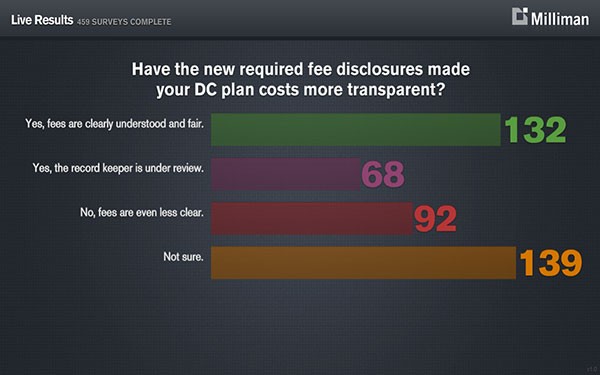ICI Frequently Asked Questions About 401(k) Participant Disclosure
Post on: 30 Июнь, 2015 No Comment

DOL’s 404a-5 participant disclosure regulation requires plan administrators (e.g. employers) to make specific disclosures to individuals (e.g. employees) participating in 401(k), 403(b), and other defined contribution plans that allocate investment responsibility to participants (participant-directed plans).
What is ICI’s position on 401(k) participant disclosure?
What are the recent developments in 401(k) participant disclosure?
Why are the rules changing?
What is a “participant-directed plan”?
When is the new regulation effective?
Generally, what does the new regulation require?
Who is subject to the new regulation?
What types of plans are subject to the new regulation?
Does the new regulation apply to individual retirement accounts (IRAs)?
Who receives the information?
How will plan fees and costs be disclosed?
What are the time frames for disclosure?
How do these disclosures differ from the information mutual funds already provide to individual plan participants?
How is the information presented?
Did the Department of Labor issue a model disclosure chart?
Does this chart have to be used?
May a plan administrator deliver disclosures electronically?
Should participants consider factors other than fees in selecting investment options?
What is ICI’s position on 401(k) participant disclosure? 
One of ICI’s long-standing priorities has been clear, effective disclosure to all investors, including disclosure for retirement plans and their participants. In January 2007, the ICI Board of Governors adopted a Retirement Plan Disclosure Policy Statement in which the Institute urged the Department of Labor (DOL) to clarify and enhance the requirement for disclosure of fees and expenses associated with 401(k) plans to assist plan sponsors in making meaningful comparisons of products and services providers. Similarly, the Institute supported action by the Department of Labor to require straightforward descriptions of all the investment options available to participants in self-directed plans. To achieve these goals the Institute recommended that the Department of Labor should require (1) clear disclosure to employers that highlights the most pertinent information, including total plan costs; and (2) that participants in all self-directed plans receive simple, straightforward explanations about each of the investment options available to them, including information on fees and expenses.
Accordingly, the Institute strongly supported the Department’s participant disclosure regulation (404a-5 ) and service provider disclosure regulation (408b-2 ), issued in October 2010 and February 2012, respectively. These regulations cover disclosure of fees and other pertinent information that plan administrators (typically the employer sponsoring the plan) must provide to their plan participants (workers) and information that service providers, such as recordkeepers and investment managers, must provide to their plan-sponsor clients.
What are the recent developments in 401(k) participant disclosure? 
Employers and workers received in 2012, for the first time, a new, standardized set of disclosures on all investment options in their plans. These new disclosures highlight any plan-level fees and ensure greater uniformity of disclosures from investment type to investment type. In this respect, information that has long been available from mutual funds—for example, the identification of investment objectives, principal strategies and risks, historical performance, and fees—now is required to be provided directly to participants for both mutual fund and non–mutual fund investments. With such uniformity, participants should find it easier to make the comparisons needed to make better-informed investment choices. Employers began receiving detailed disclosures on fees for administration, investment management, and custody in July 2012 and workers began receiving disclosures in August 2012.
Why are the rules changing? 
401(k)s are the most popular type of individual account retirement plan and have become the nation’s primary private-sector device for retirement savings. Participant direction of investments has become a dominant feature in these plans. As 401(k)s assume increasing importance for future retirees, clear, meaningful disclosure ensures that plan sponsors and plan participants have the information they need to make informed decisions.
What is a “participant-directed plan”? 
A plan that allows participants or beneficiaries to determine how to invest their own account balances among the options available under the plan.
When is the new regulation effective? 
Participants were required to begin receiving initial disclosures from plan administrators by August 30, 2012, 60 days after the July 1, 2012, effective date of the service provider disclosure regulations. If the first day of the first plan year beginning after 2011 is later than July 1, 2012, initial disclosures must be provided no later than 60 days after the first day of that plan year.
Generally, what does the new regulation require? 
The rules require that participants receive basic information on the plan and its designated investment options on or before the date they can direct the investment of their account and annually thereafter, with access to more information online and upon request, and require quarterly detailing of expenses charged to a participant’s account for administrative services. Participants receive a comparative chart on the plan’s investment options and may receive copies of prospectuses (including summary prospectuses) on request.
The new disclosures are divided into two broad categories of information.
- Plan-related information. which includes general plan information about how to give investment directions, administrative expense information (such as fees and expenses for general administrative services that are deducted from participants’ accounts, including legal, accounting, and recordkeeping services), and expense information for specific services based upon actions taken by the participant (such as a fee for taking out a loan).
- Investment-related information. which includes identifying information for each investment(such as the type of investment), performance data, benchmark information, fee and expense information, and website addresses providing additional information about investment options. All of this information must be presented in a comparative format to aid easy comparison of investment options. The DOL has provided a model chart that may be used to satisfy this requirement. The regulation also requires that participants receive (or have website access to) a general glossary of relevant investment terms.
Who is subject to the new regulation? 
Plan administrators as defined under the Employee Retirement Income Security Act of 1974 (ERISA). Recognizing that plan administrators are likely to receive much of the required information from plan service providers, the final rule protects plan sponsors from liability for inaccurate or incomplete information furnished by third-party service providers or issuers of designated investment options, as long as the plan administrator uses the information reasonably and in good faith. Compliance with the regulations is a joint effort between plan administrators and service providers.

What types of plans are subject to the new regulation? 
The regulation applies to any ERISA-governed individual account plan that allows the plan participant to self-direct investments. This would include 401(k) plans and 403(b) plans.
Does the new regulation apply to individual retirement accounts (IRAs)? 
No. IRAs—including IRA-based plans like SEPs, SAR-SEPS, and SIMPLEs—are exempt.
Who receives the information? 
Plan participants. The Department of Labor defines “participants” to include all employees eligible for the retirement plan, not only those who elect to participate in the plan.
How will plan fees and costs be disclosed? 
The method of disclosure will vary depending on the type of fee or expense. The actual amount deducted from an account for plan-level or individual-level administrative expenses must be identified on a quarterly basis. In the initial and annual disclosure, however, these administrative expenses may be described more generally. For investment-related fees and expenses, the initial and annual disclosure must provide the amount and a description of any shareholder-type fees (fees charged directly against the participant’s investment, such as sales charges). In addition, the initial and annual disclosure must reflect the total annual operating expenses of the investment, if applicable, shown as a percentage (expense ratio) and as a dollar amount based on an investment of $1,000 (assuming no returns).
What are the time frames for disclosure? 
- Initial Disclosure. The plan administrator must disclose certain information about the plan and the plan’s investment alternatives on or before the date that the participant or beneficiary is first eligible to direct his or her investments under the plan. For participants and employees who are already eligible in the first year the regulations apply (generally 2012), the deadline for most plans to furnish the initial disclosure was August 30, 2012.
- Annual Notice. After the initial disclosure, the plan administrator must provide the required plan-related and investment-related disclosures annually.
- Quarterly Notices. On a quarterly basis, the plan administrator must provide each plan participant or beneficiary a statement of the actual dollar amount of plan-related fees and expenses deducted from the participant’s account during the preceding quarter, along with a general description of the services provided.
- Updates. The plan administrator must provide a notice of any changes to plan-related information at least 30, and not more than 90, days before the effective date of the change.
- Additional Information About Investments. Certain investment-related information must be provided subsequent to the investment (e.g. information on any voting rights) or upon request (e.g. prospectuses and financial statements).
How do these disclosures differ from the information mutual funds already provide to individual plan participants? 
Although the DOL’s requirements for mutual funds closely track the SEC’s mutual fund disclosure rules, the new disclosures are more focused for an individual investing in a fund through an employer-sponsored plan. This focus facilitates participants’ understanding of the fees they pay for both administrative services and investment-related services, and allows for an easier comparison of different types of investment alternatives. The regulations, for the first time, require comparable information for non–mutual fund investment options, taking into account the differences in structure between mutual funds and other types of investments.
How is the information presented? 
All of the disclosures must be written in a way that can be easily understood by the average plan participant. The investment-related disclosures must be presented in a comparative format.
- Did the Department of Labor issue a model disclosure chart? Yes. The model chart may be used to satisfy the requirement.
- Does this chart have to be used? No. In addition, a plan administrator may include additional information that is appropriate for comparison beyond what is required.
May a plan administrator deliver disclosures electronically? 
A plan administrator may deliver participant disclosures electronically to three categories of participants:
- participants for whom computer use is an integral part of their employment duties;
- participants who affirmatively consented to receive plan communications electronically; and
- participants who voluntarily provided their plan administrator with an email address, for the purpose of receiving these disclosures, upon the employer’s request. 
The request for the email address must be accompanied by a notice (provided annually thereafter) explaining, among other things, which disclosures will be provided electronically, how to access them, and the participant’s right to opt out of electronic delivery at any time. For 2012 only, for participants with email addresses already on file, the plan administrator is not required to request the email address but would still need to comply with similar initial and annual notice requirements. For the full description of all conditions, please consult the applicable DOL rules and guidance .
Should participants consider factors other than fees in selecting investment options? 
Yes. Fund fees are one of many important elements that should be considered when making a decision about whether to select a particular fund. It is important to remember that funds’ fees and expenses represent the cost incurred for the services received from the funds, such as portfolio management and account maintenance. Participants also should consider what is appropriate for a well-diversified portfolio and consider the funds’ investment objectives, strategies, risks, and historical performance.
If two funds were identical, except for the fees and expenses they charge, the lower-cost fund would be a better option. But rarely, if ever, are funds identical. For example, equity funds typically cost more than bond and money market funds, but equity funds historically have provided a higher long-term return—even after expenses are deducted.














